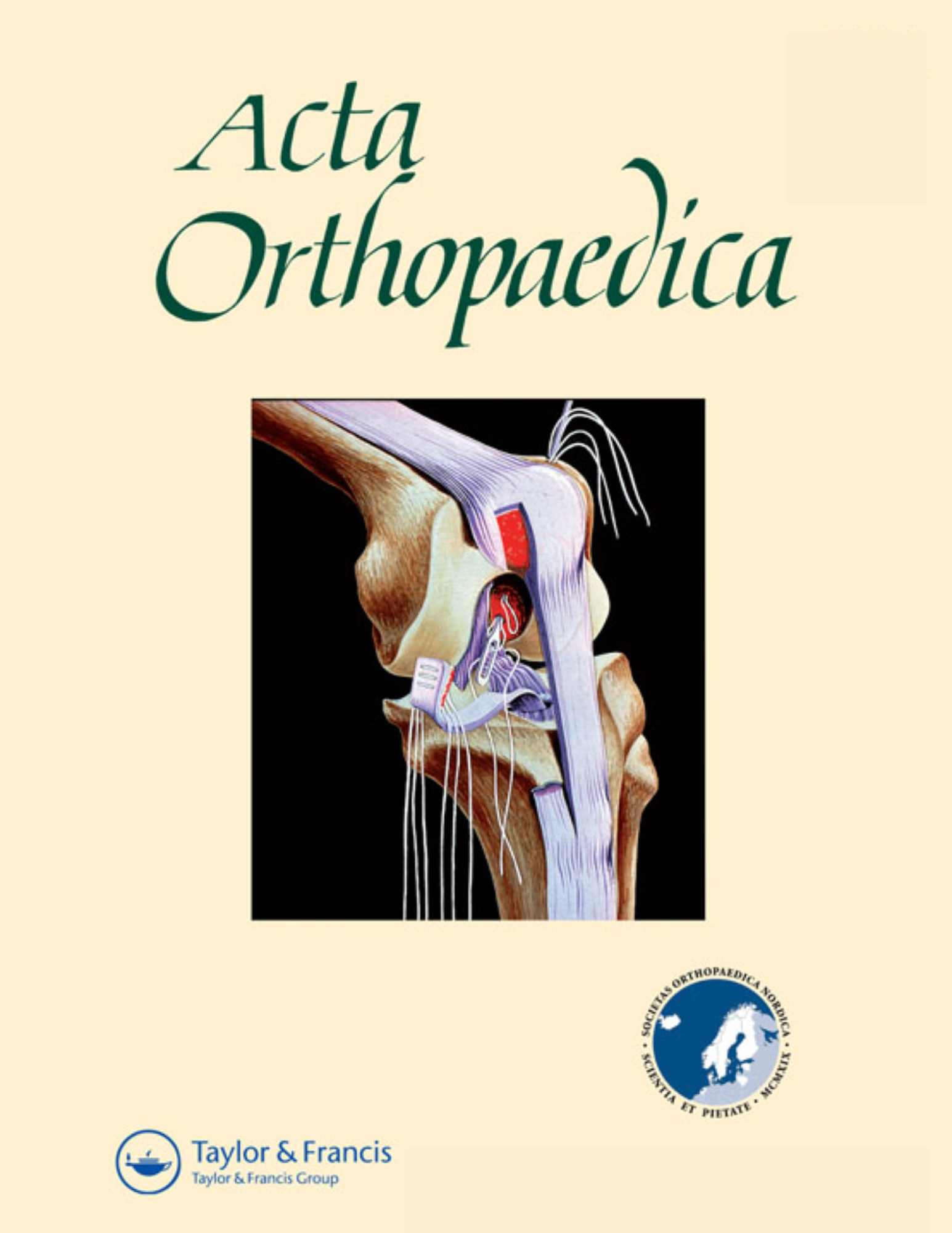
Similar migration & wear of an all-poly press-fit cup with and without screw stabilization

Similar migration & wear of an all-poly press-fit cup with and without screw stabilization
No effect of additional screw fixation of a cementless, all-polyethylene press-fit socket on migration, wear, and clinical outcome: a 6.5-year randomized radiostereometric analysis follow-up report
Acta Orthop. 2016 Aug;87(4):363-7Did you know you're eligible to earn 0.5 CME credits for reading this report? Click Here
Synopsis
36 patients who had undergone total hip arthroplasty and completed a 2-year follow-up of a previous randomized controlled trial were invited and included in this follow-up extension. Patients had received a press-fit, all-polyethylene acetabular cup, and had been randomized to placement with or without additional screw fixation. Radiostereometric analysis was performed to assess component migration and wear over 6.5-year follow-up, and the Harris Hip Score and Oxford Hip Score were used to assess clinical outcome. No significant differences were observed between groups in total 3-dimensional translation or rotation of the acetabular component. There were also no significant differences between groups in the total overall and corrected 3-dimensional wear or overall & corrected wear rates.
Was the allocation sequence adequately generated?
Was allocation adequately concealed?
Blinding Treatment Providers: Was knowledge of the allocated interventions adequately prevented?
Blinding Outcome Assessors: Was knowledge of the allocated interventions adequately prevented?
Blinding Patients: Was knowledge of the allocated interventions adequately prevented?
Was loss to follow-up (missing outcome data) infrequent?
Are reports of the study free of suggestion of selective outcome reporting?
Were outcomes objective, patient-important and assessed in a manner to limit bias (ie. duplicate assessors, Independent assessors)?
Was the sample size sufficiently large to assure a balance of prognosis and sufficiently large number of outcome events?
Was investigator expertise/experience with both treatment and control techniques likely the same (ie.were criteria for surgeon participation/expertise provided)?
Yes = 1
Uncertain = 0.5
Not Relevant = 0
No = 0
The Reporting Criteria Assessment evaluates the transparency with which authors report the methodological and trial characteristics of the trial within the publication. The assessment is divided into five categories which are presented below.
1/4
Randomization
3/4
Outcome Measurements
0/4
Inclusion / Exclusion
2/4
Therapy Description
4/4
Statistics
Detsky AS, Naylor CD, O'Rourke K, McGeer AJ, L'Abbé KA. J Clin Epidemiol. 1992;45:255-65
The Fragility Index is a tool that aids in the interpretation of significant findings, providing a measure of strength for a result. The Fragility Index represents the number of consecutive events that need to be added to a dichotomous outcome to make the finding no longer significant. A small number represents a weaker finding and a large number represents a stronger finding.
Why was this study needed now?
Press-fit fixation of acetabular cups is often used in total hip arthroplasty. A debate has emerged surrounding the use of additional fixation screws in press-fit acetabular cups. While improved short-term stability may occur, there is concern that long-term stability could be compromised through various mechanisms, such as stress-shielding and wear. However, there is a current lack of evidence from randomized controlled trials to recommend either the use or avoidance of additional screw fixation with press-fit acetabular cups.
What was the principal research question?
In total hip arthroplasty, is there any significant difference in cup migration, cup wear, and clinical outcome of a cementless all-polyethylene acetabular cup with and without screw fixation, assessed over a 6.5-year follow-up?
What were the important findings?
- There was no significant difference between the screw group and no screw group in either total 3-dimensional translation (p=0.8) or total 3-dimensional rotation (p=0.2).
- Between-group differences in individual planes were non-significant, with the exception of medial-lateral rotation: mean rotation was 0.33deg (+/-0.50) in the screw group and -0.61deg (+/-0.97) in the no screw group (p=0.004).
- There were two cases of clinically relevant rotation of the acetabular component in each group. The same two cases in the no screw group also demonstrated clinically relevant translation of the acetabular component.
- There was no significant difference in total wear over 6-year follow-up between the screw group (0.57+/-0.24mm) and the no screw group (0.53+/-0.20mm) (p=0.6). The only plane which demonstrated a significant difference between groups was medial-lateral wear (Screws: 0.19+/-0.22mm | No screws: -0.04+/-0.12mm | p=0.003).
- Corrected wear analysis, which accounted for the large degree of wear within the first year after surgery, demonstrated similar results to the overall analysis.
- Overall wear rate over 6 years did not significantly differ between the screw group (0.09+/-0.04 mm/year) and the no screw group (0.08+/-0.03 mm/year) (p=0.7). Corrected wear rate also did not significantly differ between groups (0.07+/-0.04 vs. 0.09+/-0.04 mm/year; p=0.3).
- No significant difference between groups was noted either HHS (p=0.6) or OHS (p=0.6).
What should I remember most?
In total hip arthroplasty with a press-fit acetabular cup, there were no significant differences in total 3-dimensional translation or rotation of the acetabular cup after 6.5 years, as assessed with RSA, with or without additional screw stabilization. There were also no significant differences in RSA-assessed component wear or clinical outcome after 6 years.
How will this affect the care of my patients?
The results of this study suggest that additional screw stabilization of cementless, press-fit all-polyethylene acetabular cup in total hip arthroplasty does not confer any significant mid-term advantage in migration, component wear, or clinical outcome over cups placed without additional stabilization.
Learn about our AI Driven
High Impact Search Feature
Our AI driven High Impact metric calculates the impact an article will have by considering both the publishing journal and the content of the article itself. Built using the latest advances in natural language processing, OE High Impact predicts an article’s future number of citations better than impact factor alone.
Continue



 LOGIN
LOGIN

Join the Conversation
Please Login or Join to leave comments.